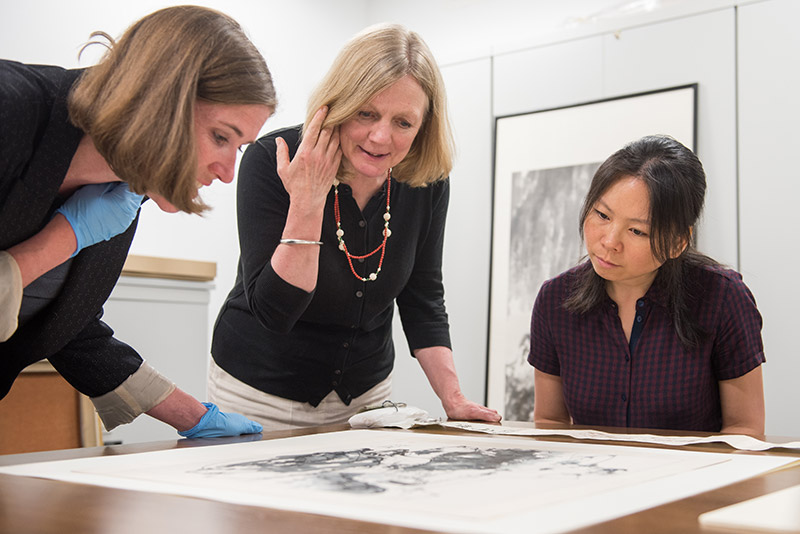Shining a spotlight on Chinese art
The Ashmolean's position as a world-leading centre for Chinese art has been made possible with the help of philanthropy. Donor support is ensuring that these incredible works will continue to be used and enjoyed by scholars and visitors for years to come.
The Ashmolean Museum’s Chinese collection is substantial. ‘It’s approaching 10,000 pieces,’ explains Shelagh Vainker, Associate Professor and Curator of Chinese Art. The collection includes ceramics, jades, bronzes, paintings, decorative arts, textiles and lacquers, and ranges in date from the Neolithic period through to the 21st century. ‘The modern paintings are some of the most special items we have though,’ she adds.
The Ashmolean started collecting modern Chinese painting in the 1950s, ‘at a time when nobody else was,’ says Professor Vainker. Mindful of the high prices and thriving forgery market associated with earlier works, the museum’s then head of department opted instead to acquire contemporary ‘literati’ paintings – works in the Chinese ink painting tradition, produced by artists alive in the mid-20th century.
It’s wonderful to be able to use the collections and the teaching together. It gives greater relevance to both.Professor Shelagh Vainker
This was the start of one of the most exquisite collections of modern Chinese paintings in the world, strengthened over the course of half a century by further curatorial purchases, as well as numerous gifts and bequests. ‘The core of the collection was very good and as a result of that, collectors have been pleased to place their modern Chinese paintings here,’ explains Professor Vainker. ‘There’s been a slow momentum over the years, but it was Michael Sullivan who really moved the collection to a new level.’
Professor Michael Sullivan (1916–2013) was a world authority on modern Chinese art and an Emeritus Fellow of St Catherine's College. Together with his wife, Khoan, he amassed one of the greatest private collections of modern and contemporary Chinese art in the world. He became a substantial, generous supporter of the museum during his lifetime, funding acquisitions, scholarships, research and exhibitions – ‘just as long as they were linked to Chinese painting,’ says Professor Vainker.

Following his death, Professor Sullivan left more than 400 works of art to the museum, along with his research papers, his archive of correspondence with Chinese artists, and a seven-figure endowment fund. As a consequence, his generosity will forever underpin work to curate, research, display, and teach Chinese art at Oxford.
‘Our collection was always prominent, but now it is now one of the most important in the West,’ says Professor Vainker, who holds the only established teaching post dedicated to Chinese art at Oxford. Handling sessions and special viewings give students unique access to the collections for their research. ‘I don’t know of anywhere else in the UK that offers that for Chinese art. It’s a fantastic opportunity,’ she notes.
In addition to serving as a scholarly resource for those at Oxford, the museum’s Chinese art collection also attracts academics from across the world. Dr Yan Liu, Christensen Fellow in Chinese Painting at the Ashmolean, believes that widening accessibility to scholars working in the field has been ‘absolutely vital’ in helping to deepen knowledge and understanding of Chinese art internationally.
I feel privileged to access to these incredible collections in my everyday curatorial work. It is always delightful to share new research with the general public through exhibitions, publications and our event programme.Dr Yan Liu
As an early-career academic, Dr Liu plays a central role in drawing together expertise in Chinese art. Her current research project explores the identity formation and expression of Chinese immigrant artists in the West, and will culminate in an exhibition featuring new works by contemporary painter Qu Leilei (b.1951) in November. ‘I am very lucky to work on Professor Michael Sullivan’s legacy. It is my responsibility to introduce Chinese art to a wider audience,’ she says.
This ‘opening up’ of the Chinese art collection has been further supported by the appointment of a Chinese Paintings Programme Co-ordinator. Felicitas von Droste works in collaboration with her colleagues to organise conferences, study days and artists’ visits, as well as tours, talks and family days for the general public. ‘It’s really important to get people coming in who don’t know about Chinese art,’ stresses Felicitas. ‘When we talk with them about the paintings, we inevitably end up talking about things beyond the art, about Chinese culture in general. It’s wonderful, and I’m delighted to be a part of it.’
Dr Yan Liu’s research is supported by the Christensen Fund. The Ashmolean’s Chinese collections have also received generous support from The Hon Mr Justice Anselmo Trinidad Reyes, Mr Whang Shang Ying, and the Fang family.